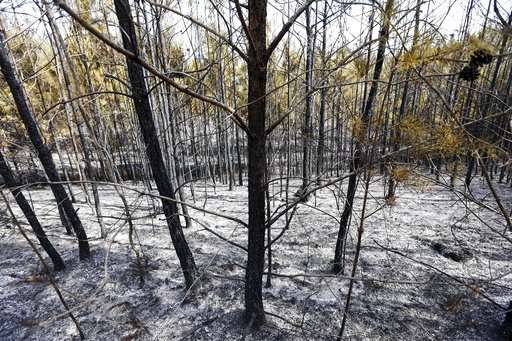Science report: Who gets hotter, wetter with climate change

A draft federal science report on the effects of global warming breaks down how climate change has already hit different regions of the United States. It also projects expected changes by region.
OVERALL (contiguous 48 states)
—The annual average temperature is already 1.18 degrees warmer the last 30 years than it was from 1901 to 1960, with daytime highs 1 degree warmer and nighttime lows 1.35 degrees higher.
—If carbon pollution continues unabated, temperatures are projected to rise another 4.83 degrees by mid-century and 8.72 degrees by the end of the century, or a few degrees less if emissions are cut somewhat.
___
NORTHEAST (Maine, Vermont, New Hampshire, Massachusetts, Rhode Island, Connecticut, New York, New Jersey, Pennsylvania, Delaware, Maryland, West Virginia and Washington, D.C.)
—The annual average temperature, which has already risen about 1.37 degrees since 1901-1960, is expected to go up another 5.09 degrees by mid-century and 9.11 degrees by the end of the century if carbon pollution continues unabated. If emissions are somewhat controlled, temperatures would go up another 3.98 degrees by mid-century and 5.27 degrees by late century.
—Extreme precipitation—rain and snow—has already gone up 17 percent compared with the first half of the 20th century and is projected to go up another 22 percent by the end of the 21st century if carbon pollution continues unabated. If carbon dioxide emissions are somewhat reduced, it would only go up 14 percent.
—The Northeast heat wave of July 2012 was made worse because of man-made climate change.
___
SOUTHEAST (Virginia, Kentucky, North Carolina, South Carolina, Tennessee, Arkansas, Louisiana, Mississippi, Alabama, Georgia and Florida)
—The annual average temperature has only gone up about 0.4 degrees since 1901-1960, the lowest of any region in the nation. It is projected to rise another 4.3 degrees by mid-century and 7.72 degrees by the end of century, if carbon pollution continues unabated. If carbon emissions are somewhat reduced, the annual temperature would rise another 3.4 degrees by mid-century and 4.43 degrees by late century.
—Extreme rain has already increased by 8 percent compared with the first half of the 20th century and is projected to go up another 21 percent by the end of the 21st century if carbon pollution continues unabated. If carbon pollution is somewhat reduced, it would only go up 13 percent.
___
MIDWEST (Minnesota, Michigan, Wisconsin, Ohio, Indiana, Illinois, Iowa and Missouri)
—The annual average temperature has already gone up 1.18 degrees since 1901-1960 and is projected to rise another 5.29 degrees by mid-century and 9.49 degrees by the end of the century, if carbon pollution continues unabated. If carbon emissions are somewhat reduced, the annual temperature would go up by 4.21 degrees by mid-century and 5.57 degrees by late century.
—Extreme rainfall has already jumped 9 percent compared with the first half of the 20th century and is projected to go up another 20 percent by the end of the 20th century if carbon pollution continues unabated. If carbon pollution is somewhat reduced it would only increase 11 percent.
—An extremely wet spring in 2013 and a March 2012 heat wave were found to be connected to man-made climate change.
___
GREAT PLAINS NORTH (North Dakota, South Dakota, Nebraska, Wyoming and Montana)
—The annual average temperature has already gone up 1.62 degrees—the most of any region—since 1901-1960. It is projected to rise another 5.1 degrees by mid-century and 9.37 degrees by the end of the century, if carbon pollution continues unabated. If carbon emissions are somewhat reduced, the annual temperature would go up by 4.05 degrees by mid-century and 5.44 degrees by late century.
—Extreme rainfall has already gone up 6 percent since the first half of the 20th century and is projected to go up another 16 percent by late century, if carbon pollution continues unabated. If carbon emissions are somewhat reduced it would be 10 percent.

___
GREAT PLAINS SOUTH (Kansas, Oklahoma and Texas)
—The average annual temperature has already gone up 0.7 degrees since 1901-1960 and is projected to rise another 4.61 degrees by mid-century and 8.44 degrees by the end of the century, if carbon emissions continue unabated. If carbon pollution is somewhat reduced, the annual temperature would go up by 3.62 degrees by mid-century and 4.78 degrees by late century.
—Extreme rainfall has already gone up 6 percent since the first half of the 20th century and is projected to go up another 20 percent by late century, if carbon pollution continues unabated. If carbon emissions are somewhat reduced it would be 12 percent.
—A hot summer 2011 in Texas and Oklahoma was found to be connected to man-made climate change.
___
SOUTHWEST (California, Nevada, Utah, Colorado, New Mexico and Arizona)
—The average annual temperature has already gone up 1.56 degrees since 1901-1960 and is projected to rise another 4.8 degrees by mid-century and 8.65 degrees by the end of the century if carbon pollution continues unabated. If carbon emissions are somewhat reduced, the annual temperature would go up 3.72 degrees by mid-century and 4.93 degrees by late century.
—Extreme rainfall has only increased 1 percent since the first half of the 20th century and is projected to go up 20 percent by the end of the century if carbon pollution continues unabated. If carbon emissions are somewhat reduced it would be 13 percent.
—California's three-year spell of hot dry weather has been connected to climate change.
___
NORTHWEST (Washington, Oregon and Idaho)
—The average annual temperature has already gone up 1.51 degrees since 1901-1960 and is projected to rise another 4.67 degrees by mid-century and 8.51 degrees by the end of the century if carbon pollution continues unabated. If carbon emissions are somewhat reduced, the annual temperature would go up 3.66 degrees by mid-century and 4.99 degrees by the end of the century.
—Extreme rainfall has increased 3 percent since the first half of the 20th century and is projected to go up 19 percent by the end of the century if carbon pollution continues unabated. If carbon emissions are somewhat reduced it would be 10 percent.
___
ALASKA
—The average annual temperature in Alaska has gone up 1.52 degrees since 1925-1960 and is projected to increase by 10 degrees by the end of the century if carbon pollution continues unabated. That's the most in the United States.
—The frequency of cold spells will decrease the most in Alaska in the future.
___
HAWAII
—The average annual temperature in Hawaii has gone up 0.75 degrees since 1925-1960.
—The extremely active 2014 Hawaiian hurricane season has been connected to man-made climate change.
© 2017 The Associated Press. All rights reserved.





















